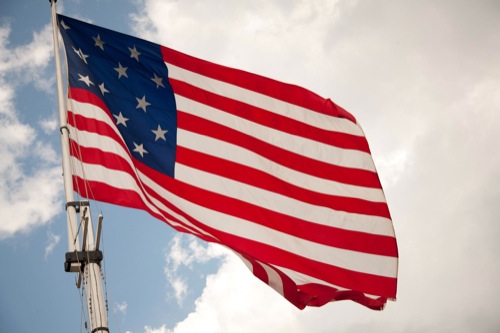
Ft. McHenry National Monument, courtesy NPS
Monuments and memorials are an ideal as old as Israel.
In Genesis, after receiving a blessing from his father, Isaac, Jacob went into the wilderness to sleep. While Jacob was sleeping, God spoke to him in a dream, promising to bless his descendants. When Jacob awoke the next morning, he built a monument of stones to remind his people of this dream and the promise that God gave to his descendants.
Humans continue to erect monuments so that in the midst of our hectic lives, we don’t forget the lessons of the past. Like Jacob, our nation has found the value of monuments, which act as reminders and memorials to important people, events, and ideas. Some are reminders of the important leaders of our country’s history, some are tributes to our cherished freedom, and others remind us of tragedies and the hope of recovery. Here are six worth remembering.
Mount Rushmore National Memorial
[ South Dakota ]
Every year, close to 3 million visitors visit the Black Hills of South Dakota to see one of the most iconic monuments in the United States: Mount Rushmore. The 60-foot sculptures carved into a granite cliff feature the faces of George Washington, Thomas Jefferson, Theodore Roosevelt and Abraham Lincoln and are a powerful symbol of America’s ideals, struggles and triumphs.
“Mount Rushmore inspires visitors to reconnect with their country,” said Amy Bracewell, park historian at Mount Rushmore. “Whether that is through pondering our history and where we have come or recommitting ourselves to our national ideals, every visitor finds a personal connection to this park.”
During the summer, groups can take part in ranger tours in the historic Sculptor’s Studio and at a Heritage Village where rangers share the history and culture of the local American Indian communities. Every evening during the summer, a program in the amphitheater includes a ranger presentation, a 20-minute movie titled “Freedom: America’s Lasting Legacy” and the singing of the National Anthem as the sculpture is illuminated. At the end of the program, active duty or retired military visitors can go to the stage to help fold the flag.
The visitors center is open year-round and offers museum exhibits and interactive videos showcasing the history of the memorial. The park also offers a half-mile trail that takes visitors to the base of the mountain, around the park to the historic Sculptor’s Studio and back to the Grand View Terrace. This trail allows visitors to see the memorial from many angles and provides the closest view you can get of the mountain.
Scotts Bluff National Monument
[ Gering, Nebraska ]
Scotts Bluff must have been a sweet sight to travelers along the Oregon, California, Mormon Pioneer and Pony Express trails. Sitting 800 feet above the North Platt River, Scotts Bluff and South Bluff could be seen from around 100 miles in every direction and were a visual cue that travelers were on the right path.
Between 1841 and 1869, more than 350,000 emigrants traveled through the area, many of them Mormons traveling from Illinois to Salt Lake City. Today, many Mormon pilgrims looking to retrace the steps of their ancestors find Scotts Bluff a fascinating stop.
“The trail was difficult, and as families traveled along the Platt River in western Nebraska, many people died of cholera,” said Tom Schaff, chief ranger at Scotts Bluff National Monument. “The grave site of Rebecca Winters symbolizes a mother making the journey across the trail with her family and how difficult it must have been to load up everything they owned and take to this rugged trail.”
Groups can hike or take a free shuttle the 1.6 miles to the top of the bluff, where they can see 50 to 60 miles on a clear day.
During summer, groups can interact with living-history interpreters in period dress and explore their Conestoga and Murphy wagons. There are several parts of the park where visitors can still see the ruts worn into the ground by pioneer wagon wheels.
The visitors center houses exhibits with artifacts and information about the 19th-century migrations and the largest collection of original sketches, photographs and paintings by William Henry Jackson, one of the pre-eminent chroniclers of the American West and westward migration.
www.nps.gov/scbl










